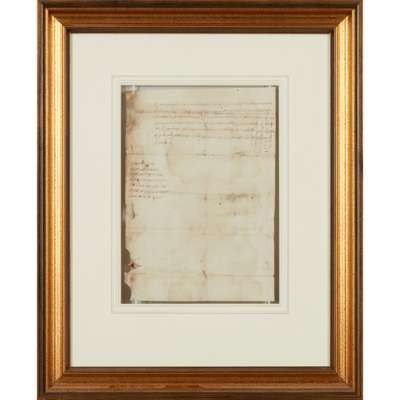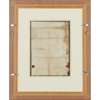
Lot 179

James VI and I (1566-1625), King of Scotland, England and Ireland
Autograph letter signed to George Keith, 4th Earl Marischal, [Edinburgh], 28th September [1589]






Rare Books, Manuscripts, Maps & Photographs
Auction: 07 February 2024 from 10:00 GMT
Description
7 lines plus signature ‘James R’ and 7-line autograph postscript, reading:
‘My littill fatt porke, the contineuall langoure I have had of your companies delaye in cumming & the feare I have of langer protracting of time yete throuch the contrairiousness of the windes hes at last constrained [me] to post away the bearere heirof to seike in qwhat ever parte of the warlde ye be in, als weill to bring me certaine novelles of youre estate as to informe you of sum thingis concerning youre cumming, qwhom willing you to credit & praying God to speid weille youre voyage, I bidd you hairthe fairweill, in haist this last sondaye of September,
James R.
I pray you excuse to the embassadouris my not writing to thaim at this tyme sen youre presence thaire may suplee that default & besydis I knaw not thaire names & styles’.
Verso with James’s red wax seal, contemporary manuscript endorsement in secretary hand (‘To .. The Erle Mareshall & Ambassador’), additional later inscription (late 18th/early 19th century). Old folds, damp-staining, paper disruption along folds partially obscuring a few words in middle of second and third lines, marginal seal tear. Repaired, mounted and framed in 1999 by Mette de Hamel
Footnote
James, writing in broad Scots to the magnate charged with securing his marriage to Anne of Denmark, seeks urgent news of the negotiations, the embassy’s return to Scotland having been held up by recurrent storms, which the following year would be found to be the work of a treasonous coven of witches, setting in train ‘the most famous witch-hunt in Scottish history’ (ODNB).
A Danish match for James had been suggested as early as 1581, and, receiving strong support from parties including Edinburgh’s merchant community, eventually prevailed over the alternative proposal of Catherine of Bourbon, sister of the future Henri IV of France, whose demands for support in his struggle for the French throne James would or could not meet. ‘On account of his rank and learning Marischal was chosen to lead the embassy sent to arrange James VI's marriage to Anne of Denmark. His great wealth must also have influenced the decision, for he bore most of the initial cost of the embassy’ (ibid.). The embassy sailed from Leith in early June 1589, and after Marischal received permission to reduce the exorbitant dowry initially demanded, the wedding was celebrated on 20th August at Kronburg castle with Marischal acting as James’s proxy.
The Scots and their new queen set sail for Scotland early in September, but their passage was held up by persistent bad weather, and eventually the decision was made to winter in Oslo. In an act of now semi-legendary gallantry, James decided to travel to Norway and retrieve his bride himself, setting sail in October and marrying Anne in person on 24th November. He spent the next five months in the country, travelling about, meeting Scandinavian theologians and scientists, and falling in love with his new wife.
Soon after the royal party’s return to Scotland in April 1590, James was confronted with the discovery of a coven of witches from Haddingtonshire, east of Edinburgh, who had allegedly conspired to assassinate him and his wife by raising the storm which had beset their return voyage. Though James was at first sceptical about the claims, one of their number convinced him of their powers by reporting a conversation he had had with Anne on their wedding night in Oslo. In the following months dozens of alleged witches were tortured, tried and executed, in what was the first major series of witchcraft trials under criminal law.
Letters entirely in James’s hand are very rare. An autograph draft sonnet was sold as part of the Robert S. Pirie collection in 2015; otherwise the only fully autograph letter traced in auction records is one offered at Sotheby’s, 1st-3rd March 1965, concerning hunting horses.
George Keith is styled in sources including the ODNB as the fourth earl Marischal, but in others as the fifth: the confusion may be due to the fact that his predecessor in the position was his grandfather, William Keith (c.1510-1581), rather than his father, also William, who died in 1580 and was known as the master of Marischal.
Provenance:
John Wilson, Autographs, Documents, Manuscripts: Catalogue Twenty-Four (1976), item 2.
Published:
G. P. V. Akrigg (ed.), Letters of King James VI & I, 1984, pp. 94-5.





